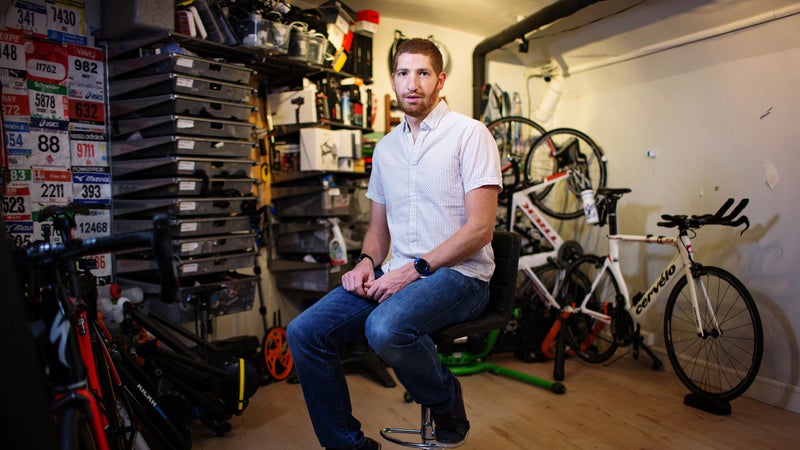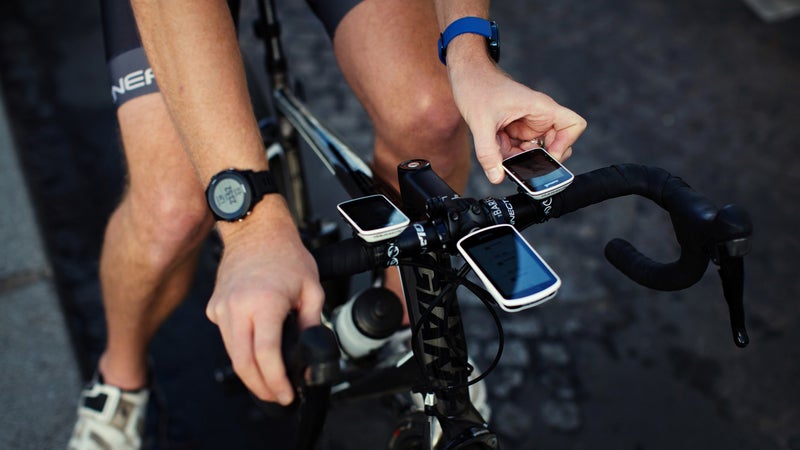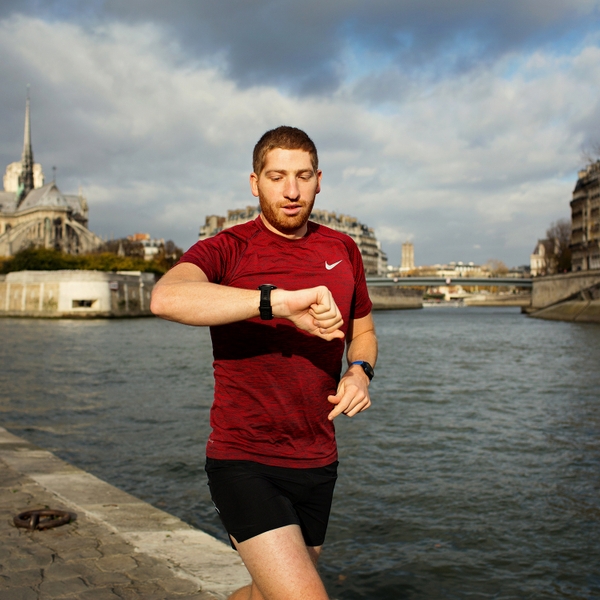The Man Behind the DC Rainmaker Gear-Review Empire
How Ray Maker, a man with no formal journalism training, built DC Rainmaker, with an audience of millions and the power to make or break your next running watch
New perk: Easily find new routes and hidden gems, upcoming running events, and more near you. Your weekly Local Running Newsletter has everything you need to lace up! .
With the latest Apple Watch on his left wrist and bright yellow Asics on his feet, Ray Maker suspects that disappointment lies just around the bend.
“It’ll probably take three minutes to find GPS,” he says, shaking his head while swiping a finger across the watch’s tiny screen. We’re prepping for a run that will be both business and pleasure. Maker, like many modern-day exercise junkies, can tell you that GPS satellites are the key to getting workout stats such as route and pace. But because he also earns a living as the blogger behind the exhaustive gear-review site , where he’s established himself as the geeks’ geek of fitness gadgetry, Maker can short-circuit when the acquisition of such information is delayed. The guy is mild-mannered and process-minded until the gizmo on his wrist does not compute.
“Plus you don’t even know when it’s still finding the satellites,” he says, trading annoyed glances between his laptop and the Apple Watch Series 3, for which he paid the full $429 retail a month earlier. “I mean, it’ll just say it’s ready to go.”
Such an electronic fib reveals the one thing that every manufacturer of fitness technology should know about Maker, who is both revered and feared for his influence: he hates unreliable data.
For Maker, who specializes in reviewing fitness electronics, including bike computers, activity trackers, and GPS watches, bad data is a waste of time—for both him and his millions of readers, who are big consumers of the equipment he covers and represent the kind of early adopters that brands crave. In Maker’s opinion, providing questionable analytics is more than simply misleading jocks with flawed engineering. Providing unreliable data is lying. Maker doesn’t easily tolerate such untruths, whether they come from the CEO of a fledgling gear startup or one of the largest brands on the planet.
“If a big tech company puts out a piece of crap, I’ll call them on it,” he says. “I’ll save people some money.”
Maker worked for Microsoft for 11 years. As a solution architect, he was entrusted with the dependable flow of information to hundreds of thousands of customers. DC Rainmaker, which he started in 2006, is a riff on the same theme. Maker often posts multiple product reviews per week, many of them running at 10,000 words and often featuring more than a hundred images and graphics. Each review has a table of contents. To the 35-year-old , who lives in Paris with his two daughters and wife, Bobbie, a professional baker, each day is about delivering the goods. The couple share a two-story workspace. The top floor is Bobbie’s bakery, the Cake Studio. The basement is Maker’s gear workshop, a windowless room he calls “the Cave.”
“We’ll see the Apple Watch results on a map later,” he says, pushing away from his laptop and starting toward the door. Maker is a long-limbed six foot two, although his frame, once Ironman-honed, has softened slightly, courtesy of the occasional croissant or pain Suisse. “There’ll be this big gap in the watch’s data,” he adds.

While mighty Apple doesn’t worry about annoying Maker (and vice versa; he accepts no advertising from the companies he covers), smaller brands, like the dozen or so whose wares currently hang off his body, certainly do. Three years ago, Runner’s World called Maker one of the . He’s even more prominent now. Each month, millions of readers pore over DC Rainmaker’s detailed product-comparison charts. His reviews often generate more than a thousand reader comments and are scrutinized by manufacturers, editors, and other gear bloggers. Pro cycling teams contact him for technical support, and the blog’s fans make pilgrimages to see the Cave’s overstuffed drawers and shelves.
Maker’s ability to make or break a product launch doesn’t come easy. He regularly works 60 hours a week. He has no staff or assistants. But stretched as he is, Maker can’t help himself. He’s as drawn to a food scale as to a new DJI drone, and the blog that began as a hobby now represents Maker’s career. He does what he loves.
We leave the workshop, which is in the Latin Quarter, and immediately cross Quai de la Tournelle. The Seine is right beside us. Notre Dame Cathedral is just to our west. But Maker is too preoccupied to absorb the beauty of the place, or even to wait for the Apple Watch to do its GPS thing. Wearing data-capturing shoe pods and insoles from four different manufacturers, a chest-strap heart monitor from a fifth, another brand’s sensor on his waistband, a GPS watch from Epson on his right wrist, carrying a third watch in one hand and an action camera in the other, Maker starts to run.
Maker was born with a huge internal hard drive. Growing up in a family of four in the Seattle suburb of Mukilteo, he liked to know how things worked. He paged through product reviews in Consumer Reports and Cook’s Illustrated. He played soccer and baseball and was a ski racer.
From a young age, Maker also wrestled with computer code. By the time he was 15, he’d written and sold software to KIRO-TV, the Seattle CBS affiliate where his dad worked as an editor and engineer. At 17, he passed a test to become a Microsoft Certified Professional. Ahead of his high school graduation in the spring of 2000, Maker asked his parents if he could skip college and enter the workforce. They said OK—so long as their son’s starting salary topped $100,000. Maker received more than 50 such offers.
In 2004, Microsoft hired Maker to design IT infrastructure, basing him in Washington, D.C. He built and implemented sprawling computer networks. He also worked on a micro level, teaching executives how to use software and writing detailed reports. Maker’s bosses demanded that he document his sophisticated work in simple language.
“Ray had patience,” says Joel Yoker, who spent years working with Maker at Microsoft. “He could easily switch from troubleshooting large system problems to focusing on a single person and saying, How can I help you? Not a lot of people have that capability.”
By 2006, Maker was 50 pounds overweight, and he decided to enter his first endurance event, the Marine Corps Marathon in Arlington, Virginia. He finished in 4 hours 24 minutes and followed it up with a half-Ironman triathlon ten months later. That same year, Maker started a blog to celebrate his fitness turnaround. As a play on both his name and his then home base, he called it DC Rainmaker.
Early on, the blog resembled the happy and somewhat mundane diary of a twentysomething endurance obsessive. A snapshot of an indoor lap pool one day, recollections of triathlon transitions another. But in late 2007, Maker posted watch. Back then the 305’s GPS capabilities were cutting-edge. Maker’s first analysis contained the seeds of his current write-ups: the story was critical of the 305’s inferior competition, and it was wonky, with a chart of his pedaling cadence. It was also granular (explaining numerous button functions) and dutiful (a dull picture of the watch’s heart-rate chest strap).
“If a big tech company puts out a piece of crap, I’ll call them on it,” he says. “I’ll save people some money.”
“One neat feature is the USB charger plugs into the wall charger, which means that you can also use that wall charger for charging basically any USB device,” Maker wrote in his now characteristic folksy prose. “Just a minor little benefit.”
The review was also dramatically longer than the standard, short-and-breezy gear reviews of the era. By early 2008, after his story went somewhat viral in the online running community, Maker’s write-up topped all the other Forerunner 305 reviews in . At the time, however, Maker was still busy working long hours for Microsoft. He continued to focus his blog on his newfound fitness lifestyle. It wasn’t until 2010, he says, that he tapped deeper into his “inner geek,” and DC Rainmaker began to evolve into the review site it is today. Eighty percent of what he now writes is gear-related.
While Maker has no background in journalism, he’s always approached the work with rigid ethical standards. Maker returns every piece of equipment sent to him for review. (No companies decline his requests for product.) Once he’s sent a device back, he then frequently turns around—either to satisfy his gear lust or for purposes of reference—and buys the same thing at retail. He refuses to accept paid travel from the manufacturers he covers. He never hesitates to write a negative review.
“I feel like I’m applying consumer common sense,” Maker told the business publication a few years back. “For me the idea that an advertiser or a company under review pays for your trip is weird.”
Maker also ignores website-performance apps like Google Analytics, which tell him that if his articles were shorter, or contained more keywords or catchphrases, he’d likely have more readers. “I’m pretty much the worst SEO expert out there. I violate all the rules,” he says. “I make up for that by just having posts that thousands of people want to tell their friends about.”
The fitness-tech industry is enjoying a moment. Since 2000, technology-focused sports-hardware companies like Garmin, GoPro, and Fitbit have gone public. Strava, a social network for endurance athletes that highlights workout details including route and intensity, launched in 2009 and has millions of users. Apple released its first watch in 2015. Last year, the wearables industry was worth an estimated $31 billion.
That boom has coincided with the rise in affiliate marketing, a phenomenon that allowed Maker to quit Microsoft in 2015 and make a living off DC Rainmaker. With affiliate programs, a cut of every sale goes to the website that successfully directs a visitor to make a purchase with a partnered retailer. The Amazon Associates affiliate-marketing program, which started 22 years ago, helped popularize the concept, which initially found its way into niche fashion blogs and price-comparison sites. More recently, affiliate marketing has gone mainstream. In 2016, The New York Times purchased , a gear-review site which had a business model built on affiliate marketing, for an estimated $30 million. (���ܳٲ������’s website also participates in affiliate marketing.) Today the overall affiliate business is reportedly worth $5 billion in the U.S. alone.
Maker got into affiliate back in December 2009. He now makes money through (a big seller of fitness tech, with U.S. and European markets) and Amazon. Like other Amazon Associates, Maker gets a cut of any sale, whether the shopper ultimately buys a GPS watch championed by his blog or just a case of toilet paper, as long as the buyer was directed from his site. (Maker won’t say how much he earns off of affiliate marketing annually, but he told me that when he quit Microsoft, his finances “didn’t change appreciably.”)

Generating revenues through affiliate programs requires an audience, and Maker’s is immense considering the size of his operation. His blog enjoys four million monthly visits, three million of which are unique visitors. DC Rainmaker’s has nearly 80,000 followers, and there are around 50,000 followers each on and . Maker understands that catering to such audiences is as important as churning out long-winded reviews. He spends hours each day responding to the hundreds—and sometimes thousands—of comments on his posts, helping readers troubleshoot issues like software glitches and compatibility problems. Even established gear manufacturers admit that Maker often acts as additional tech support.
“Our products are so sophisticated that there’s always going to be a question we haven’t thought of,” says Joe Schrick, vice president of fitness for Garmin. “We don’t have a problem with someone helping us out in terms of explanation, and for Ray, answering questions gets him a lot of hits.”
Maker is also brutally honest, a rarity among gadget reviewers who are often wary of angering advertisers. In 2015, he came upon the Scottish startup Limits, which was developing new cycling power meters. Limits claimed to be on the verge of releasing an impressively affordable ($250), pedal-axle-mounted technology. But after his inquiries to the company went largely unanswered, Maker sensed fraud. He had researched power-meter technology for years, Limits’ prototypes were nowhere to be seen, and the company’s production schedule seemed dubious. In November 2015, Maker called out Limits in a blog post for duping its nearly 2,000 crowdfunders who, through an Indiegogo campaign, had backed the company with nearly $425,000.
“To Limits’ credit, their status updates were frequent and full of all sorts of excitement,” wrote Maker. “Just like those e-mails from folks claiming that you’re the next prince of an African country you’ve never heard of.”
Limits chairman Barrie Lawson subsequently e-mailed Maker with claims of defamation. Maker shot back with a blog entry titled “Limits Responds: Says they aren’t a scam (but still lie).” All told, his Limits posts received almost 700 comments and a quarter-million visitors.
“And to think I almost went in on this,” wrote one reader. (Limits did not respond to ���ܳٲ������’s requests for comment.)
Knowing the blog’s power and the size of its audience, other gadget makers are understandably reluctant to say anything negative—or really much at all—about Maker. But one industry insider, who asked to remain anonymous, said that Maker can be a prima donna, and griped that getting him the gear he wants, when he wants it—in France, no less—can be a pain. “You have to bend over backward to remind Ray how important he is,” said the source. “He always wants to see the product super early. If your finished piece doesn’t work as he thinks it should? He can take you down.”
The morning after our run, Maker continues his assessment of Apple’s latest watch. He sits at the Cake Studio’s island counter, dressed blogger casual: jeans and a T-shirt. Large display windows are filled with sweets.
I look over Maker’s shoulder at his iPhone, which shows the Apple Watch’s captured data from our six-mile effort. “Apple likes to swoop everything,” he says as we review our route. “They just make pretty lines.” The Apple imagery does look neat, but it’s also inexact. “I didn’t run in the trees yesterday,” he says. “We didn’t jump over a 20-foot wall.”
(Two weeks after I leave Paris, Maker doesn’t hold back. “[It] takes about two to three minutes to lock HR,” he writes in the nearly 7,200-word review. “I do want to be clear here: If this was any other company, people would crucify them for this.”)
Soon we leave the bright confines of Bobbie’s kitchen and descend a winding staircase to Maker’s cluttered Cave, which looks like a mash-up of a 24 Hour Fitness and a Radio Shack. The room is filled with bikes, trainers, a treadmill, and drawers that can barely contain all of his GoPro accessories, as well as bike-computer mounts, batteries, heart-rate straps, and myriad other tech trinkets. Rows of watches and old race bibs line the walls. Tight as it is, the Cave represents an upgrade. Before leasing the workspace in 2014, Maker spent his first two years in Paris testing, storing, and blogging about gear from the family’s nearby apartment.
Maker can spend more than two months field-testing a piece of gear. He weighs products on gram scales, assesses them for packaging and fit, and lines them up against their competition.
“This is the waterproofing station,” says Maker, pointing to a glass cylinder that’s about the size of a roll of paper towels. “I can put watches in there and test whether or not they meet waterproofing standards.”
In terms of review protocol, we’re just getting started. Maker can spend more than two months field-testing a piece of gear. He’ll examine every button and switch, explore all of its screens, ports, and functions, and study the owner’s manual. He evaluates accompanying software on his smartphone and laptop. He weighs products on gram scales, assesses them for packaging and fit, and lines them up against their competition, as well as earlier generations of the same device.
Maker also measures products head-to-head via custom-made software that compares things like heart rate, power, cadence, elevation, GPS, and distance. Upon finishing a workout in which he tests multiple devices, he’ll fire up the app—called DCR Analyzer —and process results.
Our Cave visit doesn’t end before Maker tends to a little business. He throws a leg over a —a $2,000 smart stationary bike that communicates with VR cycling apps like Zwift and TrainerRoad. The Atom is so new that England-based Wattbike won’t offer it in the U.S. until this fall, but Maker has the ninth Atom to roll off the production line. However, the Atom has been out in Europe since September, and plenty of Maker’s rabid European readers (about 40 percent of his audience, with a similar percentage from North America), already own one. And they already have questions, which they’ve posed on Maker’s post previewing his .
“It’s a little slow to respond,” Maker says, pedaling in his jeans and sneakers while looking at the Atom’s controls through an iPad dashboard app. He pushes repeatedly on the Atom’s gearshift buttons. “If I do like five shifts, it takes three to five seconds,” he adds. “That’s actually a lot.”
Later in the day, Maker e-mails Wattbike as well as app developers regarding Atom-related glitches. One stateside company founder responds at 3 A.M. Nobody wants to leave DC Rainmaker waiting.
Maker’s success stems largely from two simple facts: he created a niche in the saturated gear-review market, and he invests immense amounts of sweat equity into his business.
Maker averages almost a post a day, writing about everything that could possibly be characterized as fitness tech. He’ll write short or long based on product qualities like innovation and potential marketplace impact, and a couple weekly entries often measure in the thousands of words. He meticulously photographs the unboxing of new products so that potential buyers know exactly what comes with a purchase. He generates endless DC Rainmaker YouTube videos.
“I don’t know how he does it,” Bobbie told me soon after I arrived in Paris. “I want to have a CAT scan done of the guy. Let’s see if he’s a robot.”
Indeed his unique skill set doesn’t bode well for DC Rainmaker’s future should he get burned out. “In order to find a second Ray, I’d have to have someone that can photograph, video, and write well. And understand the history of the devices,” he tells me on the last day of my visit. “I can’t give a new watch to a good photographer who will take pretty pictures but not have the watch menus displayed a certain way.”
Maker mostly enjoys being a one-man show. A trying day for him might involve a trip to La Poste, where, in his mediocre French, he’ll have to convince an intolerant postal worker that he does have mail. (He receives at least a half-dozen boxes of gear each week.) Or Maker will have to swim laps with 20 other people in his lane at one of the city’s ridiculously overcrowded public pools. But the troubles are a small price for autonomy. Plus, Maker lives in Paris. The food is great. He earns a good living. And bike rides are part of the DC Rainmaker grind.
“We’ll head west out of town,” he says, opening the Cake Studio’s glass door and rolling his bicycle onto the sidewalk. Under a brightening sky, Maker watches the launch of three different bike computers, which of course are all mounted on his Giant bike in such a way that he can monitor the performance of three different power meters while he rides. Why would Maker ever waste a single mile’s worth of opportunity to test new products?
“There’s going to be a bit of traffic for a while,” he adds, clicking a shoe into a pedal.
We reach the Paris suburb of Issy-les-Moulineaux, ride on quiet roads toward Versailles, and end up returning to a new smooth and traffic-free bike lane in the shadow of the Eiffel Tower. Before heading back to the Cave, Maker leads us to the massive Arc de Triomphe and the roundabout that encircles it. Cars fly around the iconic monument, but for Maker the ride isn’t over until we take a quintessentially Parisian victory lap.
Maker cleanly enters the fray, and I dutifully follow. In the name of survival, I take my eye off him as we go around. When the traffic momentarily relents, I look up, and there’s Maker, riding through the scrum with one hand and holding an action camera with the other, recording everything he can.
Andrew Tilin () is an ���ϳԹ��� contributing editor. He wrote about the online cycling game Zwift In October 2016.


